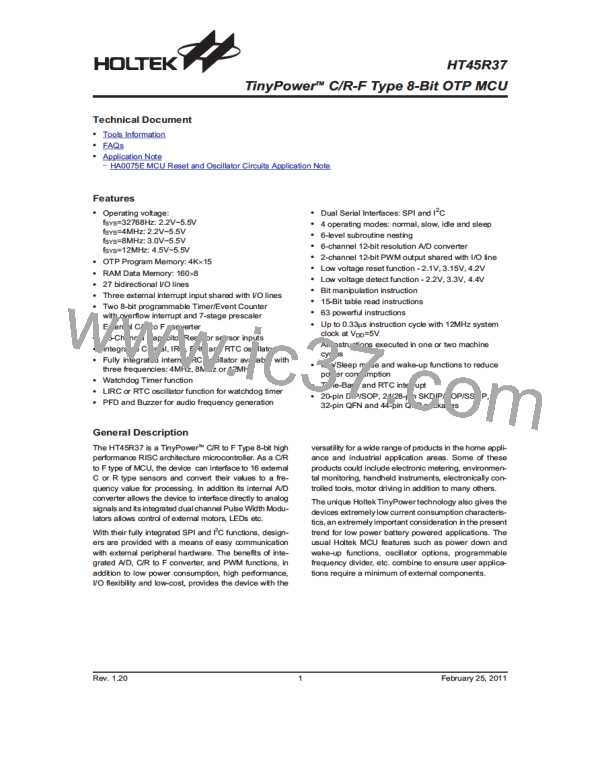HT45R37
Internal 32K_INT Oscillator
condition the QOSC bit is set to, the 32768Hz oscillator
will always function normally, only there is more power
consumption associated with the quick start-up function.
When the device enters the Sleep, Slow or Idle Mode, its
high frequency clock is switched off to reduce activity
and to conserve power. However, in many
microcontroller applications it may be necessary to keep
some internal functions operational even when the
microcontroller is in the Power-down mode. To do this,
the device has a 32K_INT oscillator, which is a fully inte-
grated free running RC oscillator with a typical period of
31.2ms at 5V, requiring no external components. It is se-
lected via configuration option.
Note that if this external 32768Hz oscillation option is
not selected, the PC3/OSC3 and PC4/OSC4 pins are
free for use as normal I/O pins.
External Oscillator
The system clock can also be supplied by an externally
supplied clock giving users a method of synchronising
their external hardware to the microcontroller operation.
This is selected using a configuration option and supply-
ing the clock on pin OSC1. Note that if this external sys-
tem clock option is selected, as it requires OSC1
external pin for its operation, the PC2/OSC2 pin is free
for use as normal I/O pin. The internal oscillator circuit
contains a filter circuit to reduce the possibility of erratic
operation due to noise on the oscillator pin.
I
n
t
e
r
n
a
l
f
R
C
3
2
K
3
2
K
_
I
N
T
Internal 32K_INT Oscillator
External 32768Hz Oscillator
System Operating Modes
With a function similar to the internal 32K-INT 32KHz os-
cillator, that is to keep some device functions opera-
tional during power down, this device also has an
external 32768Hz oscillator. This clock source has a
fixed frequency of 32768Hz and requires a 32768Hz
crystal to be connected between pins OSC3 and OSC4.
The devices have the ability to operate in several differ-
ent modes. This range of operating modes, known as
Normal Mode, Slow Mode, Idle Mode and Sleep Mode,
allow the devices to run using a wide range of different
slow and fast clock sources. The devices also possess
the ability to dynamically switch between different clocks
and operating modes. With this choice of operating
functions, and a HALT instruction, users are provided
with a high degree of flexibility to ensure they obtain op-
timal performance from the device, in terms of operating
The external resistor and capacitor components con-
nected to the 32768Hz crystal are not necessary to pro-
vide oscillation. For applications where precise
frequencies are essential, these components may be
required to provide frequency compensation due to dif-
ferent crystal manufacturing tolerances.
speed and power requirements.
Operating Mode Clock Sources
A configuration option selects whether the external
32768Hz oscillator or the internal 32K_INT oscillator is
selected. Selecting low frequency oscillators for use as
a system oscillator is implmented using bits in the
CLKMOD register.
In discussing the system clocks for the devices, they
can be seen as having a dual clock mode. These dual
clocks are what are known as a High Oscillator and the
other as a Low Oscillator. The High and Low Oscillator
are the system clock sources and can be selected dy-
namically using the HLCLK bit in the CLKMOD register.
During power-up there is a time delay associated with
the 32768Hz oscillator waiting for it to start-up. To mini-
mise this time delay, bit 4 of the RTCC register, known
as the QOSC bit, is provided to have a quick start-up
function. During a power-up condition, this bit will be
cleared to zero which will initiate the 32768Hz oscillator
quick start-up function. However, as there is additional
power consumption associated with this quick start-up
function, to reduce power consumption after start-up
takes place, it is recommended that the application pro-
gram should set the QOSC bit high for about 2 seconds
after power-on. It should be noted that, no matter what
The High Oscillator has the internal name fM whose source
is selected using a configuration option from a choice of ei-
ther an external crystal/resonator, external RC oscillator,
internal RC oscillator or external clock source.
The Low Oscillator clock source, has the internal name
fSL, whose source is also selected by configuration op-
tion from a choice of either an external 32768Hz oscilla-
tor or the internal 32K_INT oscillator. This internal fSL, fM
clock, is further modified by the SLOWC0~SLOWC2
bits in the CLKMOD register to provide the low fre-
C
1
3
2
7
6
8
H
z
quency clock source fSLOW
An additional sub internal clock, with the internal name
SUB, is a 32kHz clock source which can be sourced from
.
O
S
C
3
3
2
7
6
8
R
1
f
O
S
C
4
either the internal 32K_INT oscillator or an external
32768Hz crystal, selected by configuration option. To-
C
2
External 32768Hz Oscillator
Rev. 1.20
63
February 25, 2011

 HOLTEK [ HOLTEK SEMICONDUCTOR INC ]
HOLTEK [ HOLTEK SEMICONDUCTOR INC ]